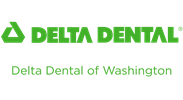
Editor's note: This article was sponsored by Delta Dental of Washington.
Past generations have thought of dental care as a “nice to have” rather than a necessity, but science has proven that attitude wrong.
“The mouth is the portal to the whole body,” says Kim Trieu, DDS, a dentist in practice at North Everett Family Dental who also teaches at the University of Washington School of Dentistry and serves on a member advisory panel for Delta Dental of Washington. Research has revealed important connections between oral health and other health conditions, such as diabetes, cardiovascular disease and even pregnancy. While the developmental milestones from toothless infant gums to a mouthful of molars have not changed, dental best practices have evolved. Today’s parents will be paying more attention to their kids’ teeth and at earlier ages than their parents did.
First tooth
The first tooth can emerge anywhere from 6 months to 9 months of age. A baby’s first tooth has always been a milestone, marked in the past with a photo and an entry in the baby book. But the arrival of the first tooth should also mark the beginning of dental care, even if an infant is still nursing exclusively.
“As soon as you see that first white tip of the tooth, you want to wipe it clean with a wet cloth. There are sugars in milk, and if you let it sit in the mouth for a long period of time without cleaning the teeth, milk can cause baby bottle tooth decay,” says Trieu, who has plenty of practice, given she is a mother to five children.
The first tooth is also a good time to introduce your child to the dentist. At this first visit, you will learn how to care for your baby’s teeth and what problems to look for as teeth emerge. Your dentist can talk to you about diet and behaviors such as thumb-sucking that can affect tooth development.
As more of your child's teeth emerge, graduate to a rubber or soft-bristled toothbrush, and introduce toothpaste when the baby begins to eat solid foods. Start with nonfluorinated toothpaste; by age 2, when kids can spit, it’s okay to use fluoridated paste.
Starting to clean teeth and to visit the dentist early on have the benefit of habituating kids to regular oral care. By the time your child reaches preschool, they’ll be confidently climbing into the dentist’s chair without any notion that other people fear it.
First molar
It might be tempting to ignore cavities in baby teeth, since they are going to fall out in a couple of years anyway. But cavities in baby teeth can have long-term effects. Aside from causing pain, decayed baby teeth can cause problems with speech and even affect the development of permanent teeth. So, receiving dental care at this stage is important, though the arrival of the first molar does mark a change in that care.
The first permanent teeth are the “6-year molars,” a term used regardless of your child’s actual age when they begin to erupt. These teeth have to last a lifetime, so it’s important to step up the oral hygiene game when they appear. Kids need to develop independence, but they are not old enough for this responsibility when the first molars emerge and may also lack the dexterity to brush molars well.
Trieu recommends parents teach kids how to brush as soon as they can, and to continue to supervise tooth brushing and coach kids in good technique until about age 9. Make sure kids brush long enough and reach every tooth surface — the molars and the back side of the front teeth are common trouble spots. Introduce flossing as soon as teeth are touching. Pro tip: Some parents find starting with flossing sticks easier than using traditional floss because the sticks are easier to grip with small fingers.
Sealants can help protect teeth during this transition, when permanent teeth are replacing baby teeth and kids are learning good oral hygiene.
“I tell kids it’s a force shield for their teeth,” says Trieu. Children without dental sealants are three times more likely to develop cavities. Made from inert materials (including the same BPA-free plastic resin used in fillings), sealants form a thin film that coats teeth and fills in the tiny pits on the surface of teeth where cavities are most likely to form. Although sealants are still catching on — only about half of elementary-school-age children receive them — they are so effective that many schools offer a sealant program. Providing sealants to nearly 7 million children can prevent more than 3 million cavities and save as much as $300 million in treatment costs.
Orthodontics and appliances
Braces used to be rare, and were most commonly seen on high school students. Nowadays, an orthodontic evaluation follows close on the heels of the first molars.
“A lot of parents don’t realize the age that the American Association of Orthodontists recommends for initial evaluation is 7 and older. Not saying that you actually have to get treatment, but it’s more to evaluate developmentally,” says Trieu. Major issues such as extreme crowding, bite problems or protruding teeth are easier to treat if they’re caught early.
“Early intervention leads to more predictable outcomes,” says Trieu. Orthodontics cause less pain and inflammation, and teeth move more easily before bones harden with age. Because kids are still growing when early braces come off, some tweaking may be required, but overall, Trieu says there can be less relapse than when teeth are moved later.
Another type of dental hardware that is becoming more common are mouthguards. Mouthguards are made from a polymer rubber material to help cushion a blow to the face, minimizing the risk of broken teeth and injuries to kids’ lips, tongue, face and jaw, especially when a child has braces. Once exclusive to boxers and football players, mouthguards, like helmets and seatbelts, are becoming standard safety gear.
“The expansion comes from increased awareness of facial injuries and their developmental consequences,” says Trieu. Some 30 percent of all sports injuries are related to the mouth and teeth, so mouthguards are appropriate for any activity with the potential for facial trauma. The American Dental Association recommends the use of mouthguards in 29 sports, for both games and practice sessions. Talking to your dentist is the best way to decide if your child needs a mouthguard, and if so, what kind to get.
Ready-made “boil and bite” mouthguards are cheap and easy to use, but they can impede speech and are not very comfortable. For frequent wear and to improve compliance, kids can have more comfortable mouthguards made at the dentist. Since they are customized, they can be made in favorite colors or even embedded with decals of favorite characters.
Wisdom teeth
The final pediatric milestone is the wisdom teeth. Although they may appear much later or not at all, wisdom teeth commonly form between the ages of 16 and 18. Just as routine removal of the appendix is no longer standard medical procedure, today your child’s wisdom teeth may not require any action.
“Our philosophy has changed in terms of wisdom tooth removal. You want your dentist to evaluate your specific child,” says Trieu. To determine if removal is necessary, your dentist will look at how much room there is in your child’s mouth, how the teeth are erupting, and the risk of impaction. Removal of these large, dense teeth is less invasive with early intervention.
Relationships
There are a lot of great resources for parents who want to learn more about oral health. Trieu recommends the Tooth Fairy Experience and the American Dental Association’s Mouth Healthy websites. But she says the most important resource is still your family dentist.
“Dental care is health care,” says Trieu. Finding the right fit with a dentist is important to form a long-term relationship that begins with the first tooth and continues into adulthood. The kind of personalized care you get from a dentist who really knows you and your child is as important to childhood health as a good pediatrician.
|
Sponsored by: |

|











